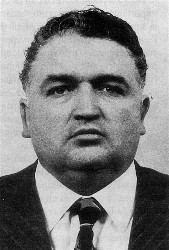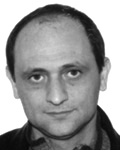
Stefano Bontade was a powerful member of the Sicilian Mafia. His actual surname was Bontate. He was the boss of the Santa Maria di Gesù Family in Palermo. He was also known as the Principe di Villagrazia − the area of Palermo he controlled − and Il Falco. He had links with several powerful politicians in Sicily, and with prime minister Giulio Andreotti. In 1981 he was killed by the rival faction within Cosa Nostra, the Corleonesi. His death sparked a brutal Mafia War that left several hundred mafiosi dead.

The Maxi Trial was a criminal trial against the Sicilian Mafia that took place in Palermo, Sicily. The trial lasted from 10 February 1986 to 30 January 1992, and was held in a bunker-style courthouse specially constructed for this purpose inside the walls of the Ucciardone prison.

Giuseppe "Pippo" Calò is an Italian mobster and member of the Sicilian Mafia in Porta Nuova. He was referred to as the cassiere di Cosa Nostra because he was heavily involved in the financial side of organized crime, primarily money laundering. He was arrested in 1985 and sentenced to 23 years' imprisonment as part of the 1986/87 Maxi Trial. He was sentenced to life imprisonment in 1989 for organising the 1984 Train 904 bombing and was given several further life sentences between 1995 and 2002. He was also charged with ordering the murder of Roberto Calvi – nicknamed il banchiere di Dio – of the Banco Ambrosiano in 1982, but was acquitted in 2007 due to "insufficient evidence" in a surprise verdict.

Michele Greco was a member of the Sicilian Mafia and a convicted murderer. Greco died in prison while serving multiple life sentences. His nickname was Il Papa due to his ability to mediate between different Mafia families. Greco was the head of the Sicilian Mafia Commission.
Salvatore "Ciaschiteddu" Greco was a powerful mafioso and boss of the Sicilian Mafia in Ciaculli, an outlying suburb of Palermo famous for its citrus fruit groves, where he was born. His nickname, "Ciaschiteddu" or "Cicchiteddu", translates from the Sicilian alternatively as "little bird" or as "little wine jug".

Salvatore Lo Piccolo, also known as "the Baron", is a Sicilian mafioso and one of the most powerful bosses of Palermo, Sicily. Lo Piccolo rose through the ranks of the Palermo mafia throughout the 1980s and he became the capomandamento of the San Lorenzo district in 1993, replacing Salvatore Biondino, who was sent to prison. Lo Piccolo was a fugitive since 1983 and had been running his Mafia affairs in hiding. With the capture of Bernardo Provenzano on 11 April 2006, Lo Piccolo had been cementing his power and rise to the top of the Palermo Mafia until his own arrest on 5 November 2007. It is believed that his family spread across Europe due to rising tensions, settling in England, Portugal, and southern Spain.
Antonino "Nino" Giuffrè is an Italian mafioso from Caccamo in the Province of Palermo, Sicily. He became one of the most important Mafia turncoats after his arrest in April 2002.

Rosario Riccobono was a member of the Sicilian Mafia. He was the boss of Partanna Mondello, a suburb of Palermo, his native city. In 1974 he became a member of the Sicilian Mafia Commission. During the 1970s Riccobono was one of the most influential members of the Commission, and the Cosa Nostra's king of the drug trafficking.
The Sicilian Mafia Commission, known as Commissione or Cupola, is a body of leading Sicilian Mafia members who decide on important questions concerning the actions of, and settling disputes within the Sicilian Mafia or Cosa Nostra. It is composed of representatives of a mandamento who are called capo mandamento or rappresentante. The Commission is not a central government of the Mafia, but a representative mechanism for consultation of independent Mafia families who decide by consensus. Its primary role is to keep the use of violence among families within limits tolerable to the public and political authorities.

Michele Cavataio, also known as Il cobra was an Italian mobster and powerful member of the Sicilian Mafia. He was the boss of the Acquasanta mandamento in Palermo and was a member of the first Sicilian Mafia Commission. Some sources spell his surname as Cavatajo.

Giuseppe Di Cristina was a powerful mafioso from Riesi in the province of Caltanissetta, Sicily, southern Italy. Di Cristina, nicknamed “la tigre’’, was born into a traditional Mafia family, his father Francesco Di Cristina and his grandfather were men of honour as well.

Giuseppe “Pippo” Calderone was an influential Sicilian mafioso from Catania, eventually becoming the capo of the Catania Mafia family.
The Second Mafia War was a period of conflict involving the Sicilian Mafia, mostly taking place from 1981 to 1984 and involved thousands of homicides. Sometimes referred to as The Great Mafia War or the Mattanza, it involved the entire Mafia and radically altered the power balance within the organization. In addition to the violence within the Mafia itself, there was violence against the state, including a campaign of deliberate assassinations of judges, prosecutors, detectives, politicians, activists and other ideological enemies. In turn, the war resulted in a major crackdown against the Mafia, helped by the pentiti, Mafiosi who collaborated with the authorities after losing so many friends and relatives to the fighting. In effect, the conflict helped end the secrecy of the Mafia.

The Greco Mafia family is historically one of the most influential Mafia clans in Sicily and Calabria, from the late 19th century. The extended family ruled both in Ciaculli and Croceverde Giardini, two south-eastern outskirts of Palermo in the citrus growing area and also rural areas of Calabria where they controlled the olive oil market. Members of the family were important figures in the Sicilian Cosa Nostra and Calabrian 'Ndrangheta. Salvatore "Ciaschiteddu" Greco was the first ‘secretary’ of the Sicilian Mafia Commission, while Michele Greco, also known as The Pope, was one of his successors.

Francesco "Ciccio" Madonia was the Mafia boss of the San Lorenzo-Pallavicino area in Palermo. In 1978 he became a member of the Sicilian Mafia Commission.
Il Capo dei Capi is an Italian biographical crime drama miniseries which debuted on Canale 5 between October and November 2007. It tells the story of Salvatore Riina, alias Totò u Curtu, a mafioso boss from Corleone, Sicily. Riina is played by Palermo-born actor, Claudio Gioè, and the series was directed by Alexis Sweet and Enzo Monteleone. The series is inspired from the eponymous book-inquiry of Giuseppe D'Avanzo and Attilio Bolzoni. It was broadcast in the UK in the spring of 2013 on the Sky Arts channel, retitled Corleone and split into 12 one-hour episodes.

Giuseppe Greco was a hitman and high-ranking member of the Sicilian Mafia. A number of sources refer to him exclusively as Pino Greco, although Giuseppe was his Christian name; Pino is a frequent abbreviation of the name Giuseppe.
Mariano Tullio Troia was a member of the Sicilian Mafia. He was on the "most wanted list" of the Italian ministry of the Interior since 1992 until his arrest in Palermo in September 1998.
The Ciaculli massacre on 30 June 1963 was caused by a car bomb that exploded in Ciaculli, an outlying suburb of Palermo, killing seven police and military officers sent to defuse it after an anonymous phone call. The bomb was intended for Salvatore "Ciaschiteddu" Greco, head of the Sicilian Mafia Commission and the boss of the Ciaculli Mafia family. Mafia boss Pietro Torretta was considered to be the man behind the bomb attack.

Salvatore Scaglione was a member of the Sicilian Mafia. He was the boss of the Noce, a neighborhood in central Palermo, since the early 1970s. In 1974, he became a member of the reconstructed Sicilian Mafia Commission. His nickname was "U Pugilista", referring to the fact he was involved in professional boxing in his youth. Together with Stefano Bontade, Salvatore Inzerillo and Rosario Riccobono, he was considered one of the main rivals of the Corleonesi Mafia clan of Salvatore Riina during the Second Mafia War in Palermo. He was killed by the Corleonesi on 30 November 1982.












